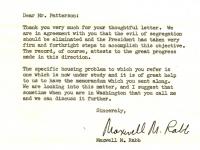Henry Patterson was the first Philadelphia director of the United Negro College Fund and was active in a number of organizations, including the National Conference of Christians and Jews and the Swarthmore Friends Meeting. He was a prolific letter writer who retained copies of letters that he wrote and also responses he received. The materials donated to HSP by Patterson’s widow include these letters as well as other sources related to his interests in topics such as civil rights, anticommunism, and Japanese internment.
In 1954, he wrote the series of letters highlighted in this lesson to persuade the venerable members of the President’s Committee on Government Contracts (including Vice President Richard Nixon and Cabinet Secretary Maxwell Rabb) to use their collective authority to prevent the builders of Levittown, Pennsylvania, from creating an all-white suburban development.


